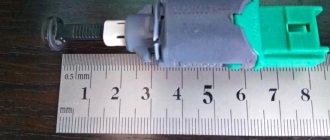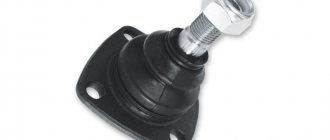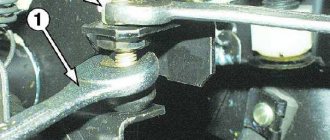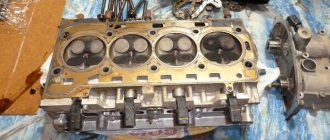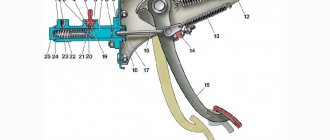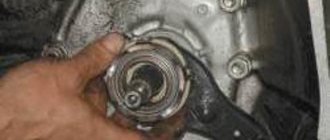Home • Niva • Chevrolet • Transmission
Chevy Niva clutch release master cylinder diagram: 1 – hydraulic drive reservoir; 2 – tank clamp; 3 – plug; 4 – body; 5 – protective cover; 6 – piston pusher; 7 – retaining ring; 8 – support sleeve; 9 – piston; 10 – piston cuff; 11 – clamp; 12 – spring; 13 – valve cage; 14 – valve spring; 15 – valve.
Device
The design of the unit is no different from those installed on other models of AvtoVAZ cars. The clutch slave cylinder (CLC) consists of the following parts:
- frame;
- fitting for pumping liquid;
- piston with plate and sealing rings;
- pusher;
- boot (cap);
- washer;
- spring.
The RCS is installed next to the plug and works as follows:
- The driver presses the pedal.
- The pusher displaces the clutch master cylinder piston, increasing the pressure in the pipeline.
- The brake fluid that fills the hydraulic drive pushes the cylinder and pusher.
- The latter moves onto the fork, which presses on the clutch basket and breaks the connection between it and the disc.
When the driver releases and stops pressing the pedal, the pressure in the system drops and the piston and pusher return to their original position under the action of a spring.
The part has article number 2123-1602510-01 and is sold at a price of 600 rubles.
Purpose and design features of the working cylinder
There are two types of cylinders in the clutch mechanism: working and main. You can learn about the purpose of the main one from the corresponding article, and today we’ll look at the Chevrolet Niva clutch slave cylinder. The Chevrolet Niva clutch system is based on the operation of a hydraulic drive, which, in turn, is inoperative without a cylinder. The essence of its operation is to directly receive the force coming from the main cylinder and thereby move the clutch release fork.
The design of the working cylinder is absolutely identical for almost all car models, therefore the principle of operation of the device is the same. The product consists, first of all, of a base, that is, a body where the following parts are assembled in a certain order:
All parts are assembled in a certain sequence, which allows the device to function correctly.
The photo below shows the working cylinder of a Niva Chevrolet.
How does the device function?
To understand the issue of purpose in more detail, let’s consider how the product’s workflow is carried out. So, when you press the main control lever (i.e. the clutch pedal), the pusher moves, which acts on the piston and it moves forward. When the piston moves under the influence of mechanical force, the pressure in the housing begins to increase. This is a process that occurs in the clutch master cylinder. After increasing the pressure, the liquid begins to be squeezed out through the discharge channel and enters the working cylinder. It contains a piston with a fork, which, under the influence of pressure, squeezes out the release bearing, thereby separating the engine and gearbox. At this moment, the corresponding gear is engaged, and then the driver releases the clutch pedal. After releasing the pedal, a return to its original position is observed: the engine engages with the transmission, which is due to the action of the pushing spring in the cylinder.
This is the essence of the functioning of the working cylinder of a Chevrolet Niva SUV. You cannot do without breakdowns and malfunctions, which are inherent in any mechanism. Thus, it is periodically necessary to repair the cylinder, since its functioning is based on friction, and, therefore, wear.
Where can I find the clutch slave cylinder in my car? On the Chevrolet Niva SUV, this product is located on the clutch housing, as on almost all cars. To do this, you need to open the hood and look at the area under the hood on the driver's side.
Fault Diagnosis
Initially, it is important to make sure that this particular element is faulty and requires replacement or repair. To do this, there are ways to identify malfunctions that will allow the car owner not to resort to the help of auto repairmen. So, if you notice the following shortcomings:
Clutch cylinder in need of repair
- incomplete clutch release;
- crunching noise when changing gears;
- there is visible damage to the cylinder body;
- oil discharge from the connecting tubes of the product is noticeable;
- decrease in brake fluid level;
- complete lack of traction.
In this case, you should pay special attention to the working cylinder and promptly carry out repairs to avoid further troubles.
Cylinder replacement and repair
Replacement is carried out in the event of irreparable defects, which include damage to the cylinder body. In all other cases, repairs will be required. But first, let's look at how to remove the slave cylinder from a Niva Chevrolet SUV and install a new repair kit.
To carry out the work, you will need open-end wrenches for “13” and “17”. Let's get started:
- We find the working cylinder hose and loosen its tip, but under no circumstances unscrew it completely.
- The cylinder is attached to the crankcase using two bolts that need to be unscrewed. The bracket is removed.
- The pusher is removed from the fork, and then the protective cap with the pusher is removed.
- With one hand you need to fix the hose tip, and with the other, rotate the working cylinder until they are disconnected.
- After disconnecting, it is necessary to drain the liquid into a container.
At this stage, the removal is complete; next, you need to replace the removed element with a new one and install everything in the reverse order of removal. After installation, the system will need to be bled (to remove air from the system).
A new working cylinder for a Chevrolet Niva will cost 300-600 rubles, so don’t be upset if the product is no longer repairable.
The product is replaced in rare cases, so if a malfunction is detected in the working cylinder, it can be repaired. For the repair procedure you will need: purchase a new repair kit for the Chevrolet Niva; standard set of tools; vice.
After the cylinder has been removed from the car, you need to proceed with the following steps:
- The removed cylinder is clamped in a vice and disassembled. The rubber boot is removed along with the pusher.
- By removing the retaining ring, the piston is removed.
- The spring with the sealing gasket is removed from the piston. The gasket must be replaced with a new one.
- Next, cleaning work is carried out on the cylinder and fitting in order to clean the channels for removing air.
- If the spring looks deformed, then it should be replaced.
- It is imperative to replace the boot and seal ring.
- Before assembling the product, all existing parts must be washed with brake fluid only.
The assembly of the cylinders is carried out in the reverse order of removal, and upon completion of the work you should make sure that there are no third-party objects that may not have been installed.
After installation, you should remove air from the system, and then check the performance of the Chevrolet Niva clutch.
Worth knowing...
The question is very often asked: “Is it possible to install a working cylinder from Shevik on a classic?” Classic car drivers often want to upgrade their car. In view of this, they resort to this issue, but at the same time, without knowing what the likelihood is that the “non-native” device will function adequately. Not at all! There is no need to install a Shev cylinder on the classic, and the reason for this lies in the principle of operation. The release bearing of a classic car is not designed for the operating mode of the rod in a pressed state, which rotates. If you nevertheless install the product on a classic, you can detect early wear of the bearing.
Now you know why your car needs this device, and how you can replace it in case of damage or wear. It is very important to identify a malfunction in the unit by early signs in order to eliminate it before complete wear and tear. Happy renovation work!
Source
Possible faults
The main sign of a breakdown of the working unit is the failure of the clutch pedal. This happens when the seals wear out. However, other malfunctions are also possible:
- Damage to the boot protecting the rod and working surface of the cylinder.
- Spring breakage.
- Rust on the working surface (appears when operating a hydraulic drive with old brake fluid containing a lot of moisture from the air).
The operation of the unit can be restored using a repair kit. Replacement is only necessary when rust appears in the cylinder.
Chevrolet Niva the older the better › Logbook › Replacing RCS 2123 (clutch slave cylinder)
While driving, I pressed the clutch several times. Moreover, very sharply (the car jumped out into the meeting) - and the clutch “does not release.” The cylinder is jammed. I crawl under the car. Exactly - the working cylinder is squeezed out and does not crawl back.
I hammered it back in the direction of the red arrow. It’s good that our car is tall - you can crawl under it. The clutch worked. But a clear sign “it’s time to change” was already given.
2123-1602510 Working cylinder 900 rubles 2101-1601211 Clutch release fork cover 50 rubles 2123-1602492 Bracket VAZ-2123 clutch working cylinder 100 rubles
21230-1602494 Thrust plate aka 21230-1602157 RCS plate 30 rubles
21010-1602596 Copper washer d 12 mm 15 rubles Bolt M8x50 1.25 - 2 pcs Spring washer 8 - 2 pcs
This is how the hydraulic clutch works
Unscrew the fluid hose from the cylinder and the cylinder itself.
(the plate was installed incorrectly - it is useless from the outside of the bracket - it should press the cylinder from the inside!)
At the same time, remove the torn cover and install a new one:
Compare old and new:
Installing a new cylinder
We put on a tube and “pump” it by gravity. (do not press the pedal!)
But the reason for the cylinder jamming is plaque and rust in the part where the cylinder rarely moves. Even with the ring removed, the piston did not come out.
Pull clutch working cylinder disassembled:
Replacement
To change the cylinder you will need brake fluid, a wrench with a 13 socket head, and a 17 wrench. Operating procedure:
- Using a 13mm wrench, unscrew the bolts securing the control center to the clutch housing.
- Disconnect the spring, bracket and the working cylinder itself from the machine.
- Remove the fork pusher.
- Remove the protective cover.
- Using a 17 key, unscrew the hydraulic drive hose.
Installation of the RCS is carried out in the reverse order of removal. After installing a new or restored RCS, it is necessary to
Important: if only one boot is damaged, it is enough to replace only it without disconnecting the hose. Part number – 2123-1602518. The boot costs from 45 rubles, but it is better to buy high-quality spare parts at a price of 140 rubles and above.
Clutch slave cylinder diagnostics
The cylinder is located on the clutch housing. To visually find it and diagnose the condition of the part, you need to open the hood and examine the space on the driver’s side.
First you need to determine that the problem lies in this part, and begin to repair or replace it. To do this, there are a number of measures that allow you to identify the problem yourself, without the need to visit a car service center. You should pay attention to some signs that occur while driving:
- reducing clutch pedal travel
- crunching sound when changing gears
- there is visible damage to the cylinder body
- oil leaks on connecting pipes
- decrease in brake fluid level
- no response to pressing the clutch pedal
In this case, the part must be repaired or replaced.
Replacement is necessary when irreparable defects occur, such as damage to the cylinder body. In other cases, repairs can be made. In this case, you can remove the working cylinder of the Niva Chevole and install a repair kit.
- To work, you need to prepare keys for 13 and 17. Work begins with loosening the hose; do not unscrew it completely.
- To release the cylinder, unscrew the two bolts, after which you can remove the bracket.
- To release the pusher from the fork, you need to remove the protective cap from it.
- Holding the hose with one hand, rotate the cylinder until it is disconnected from the hose.
- After this, you need to drain the liquid from the system into a container.
At this stage, the cylinder has been removed and a new part can be installed by performing the steps in reverse order. After installation, the system is bled to remove any remaining air from it.
The cost of a new clutch slave cylinder is quite low, so a complete replacement is recommended. But if the condition does not cause any complaints, then you can purchase a repair kit to carry out independent repairs.


